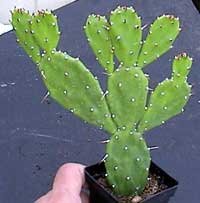Tuesday, April 18, 2006
Opuntia cacti

Opuntia cacti are native to almost the entire United States where the enironment is very changeable from desert to quite rich moist soil.
They are one of the largest genus and contain an incredible range of plants from small through true giants. One common factor with the oputia cactus is that they have 'pads' which are joined together giving them the common name of bunnies ears.
Many produce edible juicy fruits too and some are commercially available as Prickly Pears, such a plant is Opuntia ficus indica - easily to grow, flower and fruit!
The vast majority of the Opuntia cactus are easy to grow growing plants and make excellent house plants which will produce large colourful flowers in brick red, yellow and orange.
Temperature
The habitat where Opuntia come from can be very dry and hot or quite rich humid so it's difficult to suggest a single growing temperature but typically they should be kept above 5C during the winter and around 30C during the summer. Some such as Opuntia chlorotica, Opuntia compressa, Opuntia phaeacantha & Opuntia vestita are hardy in the UK if planted in a well drained and sheltered position.
Pot Type
Opuntia cactus are best grown in a terracotta type pot which has a heavy base as the plants can grow very tall. It should have at least one drainage hole in the base and it should be unglazed. This type of pot allows good drainage and allows the compost (therefor roots) to breath.
Compost
Opuntia prefer an open and free draining but rich compost which should consist of:
1 part John Innes no. 2 compost
1 part peat or coir based compost
1/4 part sharp sand or grit
1/4 part broken crock pieces (small)
Watering
The plants should be kept almost completely dry during the winter months, only water them to prevent the roots from completely drying out, once a month should be fine. From March onwards the plant will begin to grow and watering should be increased gradually until late May when the plant should be in full growth.
As the compost is very free draining and the pot used is porous you can safely water this type of cactus at least once a week during the summer so long as the plant pot is allowed to drain and not sit in a tray of water.
During hot weather you may need to water the plants once a day so long as the plant is actively growing.
From late September watering should be reduced to force the plant to go in to a state of semi dormancy, by November you should be back in to the winter watering regime.
Lighting
Grow most species of Opuntia cacti in full sun during the summer and winter avoiding only the harshest summer sun, if kept too dark they may become overly lush and could be prone to rotting due to over watering, they will also be shy to produce flowers.
Feeding
If the compost is fresh then feeding may not be necessary at all, if the plant hasn't been repotted recently then half strength general purpose fertilizer can be used at watering time from May onwards once a month. Do not feed the plants from September onwards as this can cause lush growth which can be fatal during the darker colm months.
Repotting
Repotting should be done every other year or every three years, annual potting is not necessary. Remove the plant from its put by wrapping newspaper around the stem if it is very spiny. Carefully tap it out of the pot and remove the old compost to examine the roots, if any are damaged or showing signs of rotting they should be removed as close to the plant as possible.
Re plant the cactus using the same mix of compost as it was originally in (fresh) and use a pot just slightly wider then the width of the cactus. Do not be tempted to over pot as this will cause the unused compost to go stagnant and you may loose the plant.
Cactus, Cacti, Desert, Opuntia